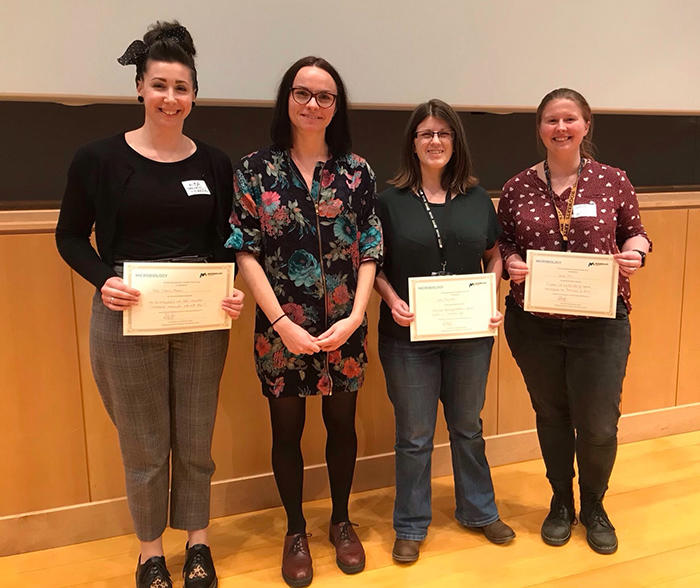Microbes in Norwich: Presentation prize winners
Posted on April 17, 2019 by Microbiology Society
This year, the Microbiology Society’s journals will be sponsoring oral and poster prizes at conferences and meetings around the world. We will be getting to know a little bit more about the prize winners and their research.
Microbes in Norwich is a biennial conference, showcasing the wide variety of microbiological research taking place at the Norwich Research Park. We spoke to the three winners of the Microbiology poster prize; Emma Ainsworth, Leanne Sims and Alba Pacheco-Moreno.

Poster Prize winners with Alexandra Howat; Microbiology Society Publishing Operations Manager
(Left: Alba Pacheco-Moreno, Alexandra Howat, Emma Ainsworth, Leanne Sims)
Alba Pacheco-Moreno
What was the title of your winning poster?
How do barley plants and root-associated Pseudomonas communicate with each other?
Who or what inspired you to be a scientist?
When I was a kid, I used to explore a lot on my own. I think that understanding how things work has always fascinated me. However, the trigger was one of my lecturers at the university; his enthusiasm and passion made me realise that I wanted to become a scientist.
What are you currently working on and what area of your research excites you the most?
I currently work on plant-microbe interactions. Particularly, how the root microbiota is shaped and controlled by the plant is an area that particularly interests me. Developing increased knowledge in this area could be used to boost crops yields.
How would you explain your poster to a child under 10?
Plants and microbes live together in a very close relationship. Many of these microbes help the plant to grow healthier, but nowadays we don’t know much about how they speak to each other. My work tries to understand the language that makes plants interact with good microorganisms.
What would you be doing in your career if you weren’t a scientist?
I don’t imagine myself doing something else, to be honest. However, I am an Agronomist by background, so I think that I would be working in the field if I weren’t a scientist.
Emma Ainsworth
What was the title of your winning presentation?
Long-Read Sequencing Determines Genome Structure in Salmonella Typhi
Who or what inspired you to be a scientist?
Chris Jennings, Mark Evans and Michelle Richardson. These outstanding and wacky A-level science teachers changed my university path completely. They helped me develop a ridiculous passion for mass spectroscopy and biochemistry. They also helped me to get a Nuffield Scholarship at the John Innes Centre, where I loved the working environment.
What are you currently working on and what area of your research excites you the most?
I'm using long-read sequencing to determine if Salmonella Typhi samples have undergone structural changes, where large genome fragments shift position and orientation due to homologous recombination between the multiple ribosomal operons harboured by most bacteria. With sequence reads of several kb (which span the length of the ribosomal operons), we are excited to see if genome rearrangements are more common and influential than previously thought.
How would you explain your poster to a child under 10?
All living things have DNA within their cells. DNA is a record of instructions that tells each cell what job it has. Bacteria are able to rearrange the order of their DNA instructions, which helps them survive new environments and situations. I look at the order of their DNA instructions.
What would you be doing in your career if you weren’t a scientist?
I am fortunate to have my dream job, and lucky to be a part of a newly formed group with such a promising and exciting future. If I wasn't a scientist, I would love the excitement of being an archaeologist or palaeontologist, but I would most likely be an accountant.
Leanne Sims
What was the title of your winning poster?
Purification and characterisation of isoprene monooxygenase from Rhodococcus sp. AD45
Who or what inspired you to be a scientist?
As a child I loved Jurassic Park, it made me really want to learn about genetics. During my undergraduate study I was fortunate to complete a project in a really friendly lab group where I developed a love for environmental microbiology, and decided I really wanted to be involved in scientific research.
What are you currently working on and what area of your research excite you the most?
I’m working on characterisation of the enzyme which catalyses the first step of bacterial isoprene degradation, isoprene monooxygenase. Isoprene is a highly abundant and climate-active gas produced mainly by plants. I’m really excited to explore the substrate range of this enzyme and identify any potential biotechnology/bioremediation applications.
How would you explain your poster to a child under 10?
I work with a bug that eats a nasty, smelly gas! My job is to find out how it does that, what other weird things it can eat and whether we can use it to get rid of other nasty gases.
What would you be doing in your career if you weren’t a scientist?
I can’t really imagine myself anywhere else anymore! Maybe running a tea shop with my Mum, as we both love to bake.
Stay tuned for more prize winners!

